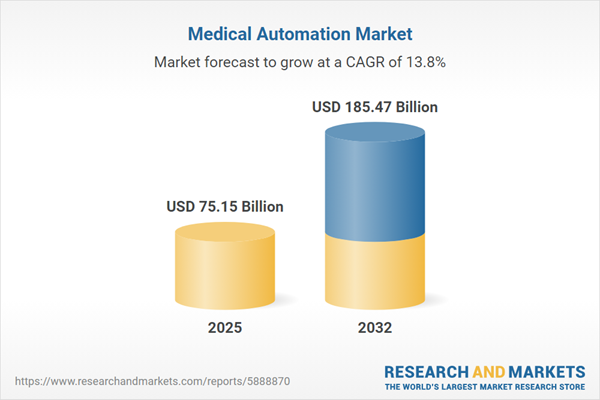Speak directly to the analyst to clarify any post sales queries you may have.
The medical automation market is advancing rapidly as healthcare leaders seek integrated solutions that improve outcomes, support operational excellence, and address ongoing industry pressures. Strategic decision-makers are re-evaluating workflows to capitalize on next-generation automation across clinical, diagnostic, and administrative arenas.
Market Snapshot: Medical Automation Market Size and Growth
The medical automation market grew from USD 65.85 billion in 2024 to USD 75.15 billion in 2025. It is expected to continue its expansion at a CAGR of 13.81%, reaching USD 185.47 billion by 2032. This dynamic growth reflects rising investment in intelligent systems designed to streamline workflows, minimize manual errors, and enable real-time clinical decision-making.
Scope & Segmentation: Navigating the Medical Automation Landscape
- Product Types: Laboratory automation systems, patient monitoring systems, pharmacy automation, and robotic surgical systems cover routine to complex healthcare needs.
- Application Areas: Clinical diagnostics, drug compounding, hospital management, patient monitoring, and surgical procedures enable end-to-end healthcare optimization.
- End Users: Ambulatory surgery centers, general and specialty clinics, imaging centers, pathology labs, private and public hospitals, and pharmacies are major adopters.
- Technology: Artificial intelligence, machine learning (including deep learning and natural language processing), blockchain for security, Internet of Things (IoT), and robotics drive automation advancements.
- Components: Hardware such as actuators, control systems, and sensors; services including consulting, maintenance, and training; plus application, middleware, and operating software solutions.
- Geographic Regions: Americas, Europe, Middle East, Africa, and Asia-Pacific, with strong activity in the US, China, India, major EU economies, Japan, and emerging regional hubs.
Key Takeaways for Medical Automation Decision-Makers
- Automation empowers healthcare providers to redeploy skilled personnel from repetitive tasks to more patient-centric initiatives, raising clinical value.
- Advanced machine learning and integrated IoT platforms enable earlier disease detection and proactive monitoring, supporting improved patient care pathways.
- Stakeholders face new regulatory complexities, creating demand for platforms with robust audit trails and compliance features, especially in cybersecurity and interoperability.
- Regional strategies must address diverse priorities: established markets emphasize seamless integration, while emerging regions focus on scalable, cost-effective automation.
- A competitive market rewards vendors with open, interoperable platforms for easier technology integration and user adoption across health systems.
- Strategic partnerships—whether with technology innovators, academic institutions, or payers—can accelerate bespoke solution development and unlock unique market opportunities.
Tariff Impact: Navigating 2025 U.S. Policy Shifts
New U.S. tariff measures commencing in 2025 are influencing sourcing strategies for automation components such as actuators, sensors, and control modules. Increased import duties are motivating manufacturers and healthcare systems to explore regional supply chain diversification, renegotiate service-level agreements, and adjust bundled software-hardware models to limit cost escalation and operational risk. Some organizations are turning tariffs into opportunities by investing in domestic partnerships and refining inventory management to buffer against import volatility.
Methodology & Data Sources
This report uses rigorous primary and secondary research to ensure a robust industry evaluation. Sources include peer-reviewed journals, regulatory filings, financial reports, interviews with industry leaders, and benchmarking against established standards. Quantitative data validation and scenario analysis provide additional assurance regarding the reliability and relevance of market insights.
The Strategic Value of the Medical Automation Market Report
- Gain data-driven clarity on emerging opportunities, competitive positioning, and best-fit technology investments tailored for healthcare enterprise growth.
- Uncover actionable intelligence to inform procurement strategies, partnership pursuits, and regulatory compliance amid shifting international policy and technological trends.
Conclusion
This comprehensive report provides the insights required to successfully navigate the evolving medical automation landscape, optimize strategic priorities, and drive sustainable value creation in global healthcare settings.
Additional Product Information:
- Purchase of this report includes 1 year online access with quarterly updates.
- This report can be updated on request. Please contact our Customer Experience team using the Ask a Question widget on our website.
Table of Contents
3. Executive Summary
4. Market Overview
7. Cumulative Impact of Artificial Intelligence 2025
Companies Mentioned
The companies profiled in this Medical Automation market report include:- Thermo Fisher Scientific Inc.
- Danaher Corporation
- F. Hoffmann-La Roche AG
- Siemens Healthineers AG
- Abbott Laboratories
- GE HealthCare Technologies Inc.
- Becton Dickinson and Company
- Intuitive Surgical, Inc.
- Tecan Group AG
- Agilent Technologies, Inc.
Table Information
| Report Attribute | Details |
|---|---|
| No. of Pages | 180 |
| Published | October 2025 |
| Forecast Period | 2025 - 2032 |
| Estimated Market Value ( USD | $ 75.15 Billion |
| Forecasted Market Value ( USD | $ 185.47 Billion |
| Compound Annual Growth Rate | 13.8% |
| Regions Covered | Global |
| No. of Companies Mentioned | 11 |









